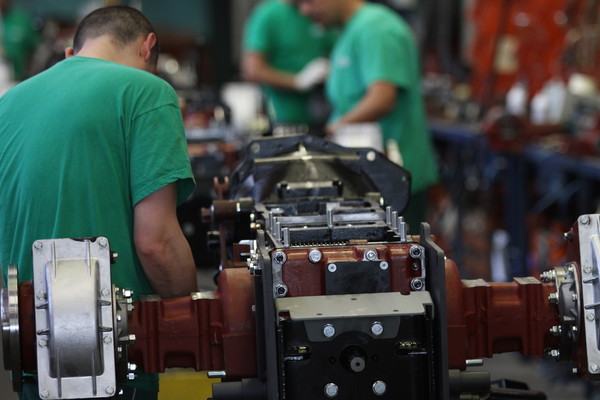
Agricultural machinery: variability in a growing market
The agricultural machinery market closed 2017 ahead in Italy and on the increase in all the major world market. Substantial growth in Italy and the leading European countries were assigned mainly to the need to reduce the stock of tractors and transporters in inventories ahead of the enactment of new norms for type-approval. Rural Development Program funds and financing released by INAIL for machinery with high safety standards were also in growth
The Italian agricultural machinery market came to the end of 2017 with substantial increases for many type of products. Other than the strong gains of tractor registrations, up 23.8% with 22,700 units sold, transporters climbed by 24.4% on 963 units, and combine harvesters and trailers were on the positive side, ahead by 2% for 350 units and 1.4% for 9,377 units respectivey. Also components showed a sharp increase, estimated at between 10 and 15% by the Comacomp Components Association, following a minus 2.2% in 2016 based on partial information not statistically measurable.
The increase in exports
The year was positive for the manufacturers in the sector in the wake of a 2% drop in production in 2016. The balance sheet for 2017 grew thanks to the level reached by domestic sales and rising exports. Tractor sales in Europe climbed 3% in October, were up 4.5% in the United States in December and were boosted by 29% and 11% in Russia and Brazil respective in the month of September. In the first months of the year India reported gains of 19% and China reported plus 33%. The Italian National Statistics Institute disclosed an increase of Italian agricultural machinery exports over the first ten months of the year up by 7.5% on value at € 3.89 billion. As usual, Europe was the largest market in accounting for 68% of these exports for a gain of 9.5%. The percentage drops to 54% taking all the European Union 28 Member States and exports at 4.8%. Export increases in the Asian countries grew 8.9% and were up by 7.9% for Africa.
A trend up for interpretation
This positive year was discussed this afternoon by FederUnacoma President Alessandro Malavolti at a press conference in Verona. He said these developments were due to a combination of factors which must be analyzed for evaluating them. Cited were the EU Rural Developments Plans enacted at the beginning of 2017 for the application of funding which encouraged sales of machinery if it is correct that three Measures including their internal funding for acquiring agricultural machinery reported progress in allocating them. The Measures at 4. Investments in physical assets; 6. Farm and business development; 8. Investments in forest area development and improvement of viability of forests. By September 2017 Measure 4 had committed 9.4% of the funds allocated for the entire 2014-2020 period. In nine months in 2016 5.5% had been allocated.
The INAIL funds commitment
Also INAIL, the National Insurance Institute for Work Accidents, set aside € 45 million for the purchase of machinery with elevated safety standards which contributed to the development of demand by assigning almost all the financing allocated on the basis of requests for the purchase of tractors and other farm machinery. In detail, € 4.5 million of the € 5 million for young farmers were assigned for 132 requests submitted, € 39 million of € 40 million went for the 1,344 requests submitted.
Forcing on the Mother Regulation
On the other hand, the significant growth of registrations of tractors and transporters was due only partially to normal demand dynamics and has to be attributed to the arrival of the Mother Regulation. In fact, toward the end of the year manufacturers embarked on marketing promotions to lower their inventories ahead of the enactment of new European Union regulations set for January 1st, 2018 application of new criteria for type-approval to eliminate from the market machinery in compliance with outdated criteria.
Malavolti noted, “It was actually the machinery, meaning tractors and transporters, for which the Mother Regulation was applied, that were reported for the rise in registrations and in the month of December in light of the deadline there were greater registrations which signaled a national average for tractors of 118%.” Given that the Mother Regulation was enacted throughout the European Union there was a trend similar to Italy’s noted in the main countries. The average registrations of tractors in Austria, France, Germany, Spain, the UK and Italy at the end of 2017 came to 16% with a peak of registrations in December alone at more than 140%.
The outlook picture
There is a degree of optimism for the current year due in part to the expectation of increasing farm income which could encourage the purchase of new machinery and especially the support provided by the EU Rural Development Plans. Malavolti said, “Anyway, the fact that a high percentage of registrations were driven by the deadline for the Mother Regulation which could produce a backlash in the new year with a normal decline in registrations compared to the drugged gains in 2017.” A degree of stabilization could come about thanks to a more conspicuous and systematic use of the RDPs. “We want to have the percentages of RDP use overall to be higher and to see that the various Measures are used more for the purchase of agricultural machinery,” Malavolti said and added, “But what’s important is that the spending commitments are progressive and have confidence in the fact that by the end of 2018 a certain level of spending will be reached to avoid returning part of the unspent EU funds, something that will probably lead to a speedup in the closing months of the year.








